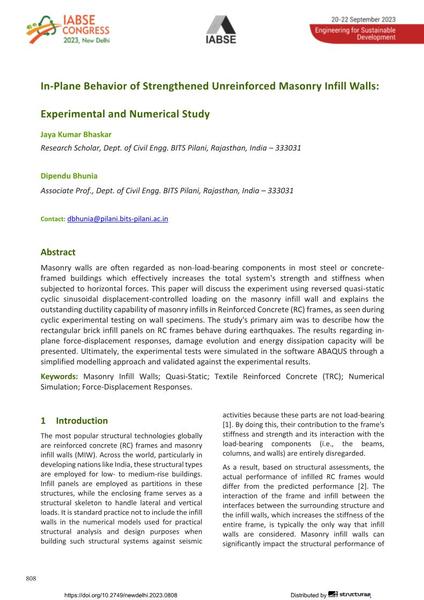In-Plane Behavior of Strengthened Unreinforced Masonry Infill Walls: Experimental and Numerical Study

|
|
|||||||||||
Bibliographic Details
| Author(s): |
Jaya Kumar Bhaskar
(Research Scholar, Dept. of Civil Engg. BITS Pilani, Rajasthan, India – 333031)
Dipendu Bhunia (Associate Prof., Dept. of Civil Engg. BITS Pilani, Rajasthan, India – 333031) |
||||
|---|---|---|---|---|---|
| Medium: | conference paper | ||||
| Language(s): | English | ||||
| Conference: | IABSE Congress: Engineering for Sustainable Development, New Delhi, India, 20-22 September 2023 | ||||
| Published in: | IABSE Congress New Delhi 2023 | ||||
|
|||||
| Page(s): | 808-815 | ||||
| Total no. of pages: | 8 | ||||
| DOI: | 10.2749/newdelhi.2023.0808 | ||||
| Abstract: |
Masonry walls are often regarded as non-load-bearing components in most steel or concrete- framed buildings which effectively increases the total system's strength and stiffness when subjected to horizontal forces. This paper will discuss the experiment using reversed quasi-static cyclic sinusoidal displacement-controlled loading on the masonry infill wall and explains the outstanding ductility capability of masonry infills in Reinforced Concrete (RC) frames, as seen during cyclic experimental testing on wall specimens. The study's primary aim was to describe how the rectangular brick infill panels on RC frames behave during earthquakes. The results regarding in- plane force-displacement responses, damage evolution and energy dissipation capacity will be presented. Ultimately, the experimental tests were simulated in the software ABAQUS through a simplified modelling approach and validated against the experimental results. |
||||
| Keywords: |
numerical simulation masonry infill walls Quasi-static textile reinforced concrete (TRC) Force-Displacement Responses
|
||||
